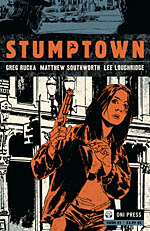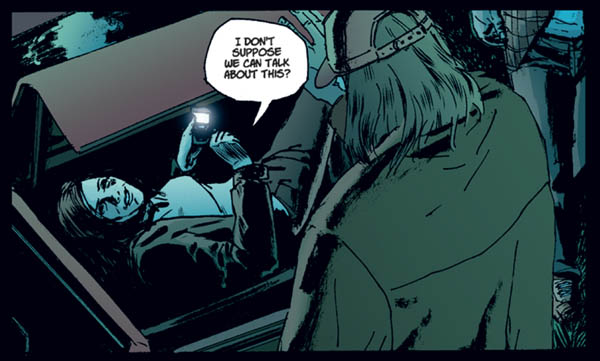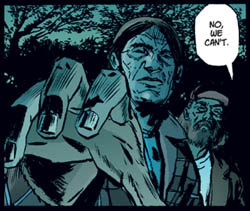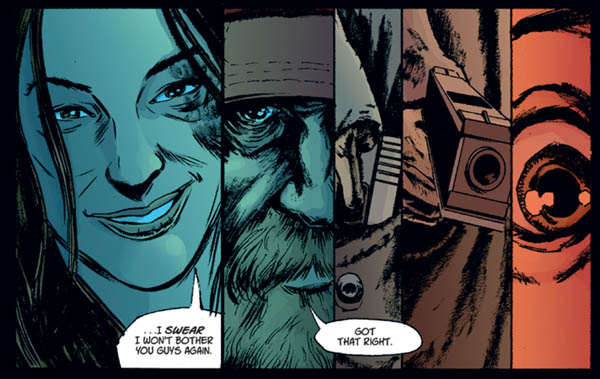 Written by Greg Rucka
Written by Greg Rucka
Art by Matthew Southworth
40 pages, color
Published by Oni Press
If I had to try and sum up my general feeling about the premiere issue of Greg Rucka and Matthew Southworth’s Stumptown in just a handful of words, I suspect it would involve, "Back to basics Rucka." Rucka’s career in comics started just over a decade ago with Whiteout, and while he’s tackled his fair share of comics since then in a wide variety of genres, it’s the mystery/investigative/thriller genres that he’s forever associated with in my head. Stumptown goes back to those roots, and I don’t think it’s a small coincidence that (along with his current run on Detective Comics) it’s one of his strongest comics in years.
Rucka opens up Stumptown in media res, as Dex Parios is in a particularly bad situation. When handled properly, starting the story in the middle of the action and then leaping backwards works well, but it’s a technique that can just as easily fall flat on its face. It works here not merely because those first five pages are a particularly tense situation for our protagonist, but because Rucka understands that you need to keep the book moving even when you then shift back into the past. Rucka moves just one day earlier, so that Dex’s dangerous confrontation is rapidly approaching even as she starts her search for a missing 18-year old. Even as Dex begins her preliminary fact-finding, Rucka keeps the stakes building; two very different confrontations about Dex’s search happen in short order, and then things go from bad to worse. By the time Stumptown #1 returns to its opening moments, everything that led us as readers to that point helps put those pages into context, and what looks like a bad situation is undoubtedly worse.

As a character, it’s easy to fall into liking Dex. Like so many stories of this genre, she’s full of flaws. She’s a gambler who doesn’t know when to quit, she’s a little brash, and while she talks a good game the end result doesn’t always go in her favor. Rucka tries to show us all the sides of Dex, though, and it works. We meet her younger brother that she cares for, and the relaxed relationship between the two feels startlingly real. Readers also get to see just how Dex operates as a private detective, picking up on small facts about the vanished girl’s departure that are later related to us. It’s a good way to have us learn about Dex, and makes her feel like a good protagonist. She’s got her problems, but she’s still someone you want to see succeed.
 Up until this point the most I’d seen of Matthew Southworth’s art was his inking a few issues of Infinity, Inc. As it turns out, he’s an excellent artist in his own right, drawing in a heavily-realistic style that will bring to mind similar artists (and past Rucka collaborators) like Michael Lark and Stefano Gaudiano. He has an excellent point of view for his art, letting us see through Dex’s eyes for a hand coming towards her, for instance, or using a series of slim panels to shift the action from one moment to the next in rapid succession when Dex suddenly realizes just how bad a situation she’s in. It’s a tight, narrow focus that lets him zoom in on each individual moment, and he handles the script perfectly, taking care to capture details like a bruised face, bags under the eyes, or the pupil dilating in a moment of fear.
Up until this point the most I’d seen of Matthew Southworth’s art was his inking a few issues of Infinity, Inc. As it turns out, he’s an excellent artist in his own right, drawing in a heavily-realistic style that will bring to mind similar artists (and past Rucka collaborators) like Michael Lark and Stefano Gaudiano. He has an excellent point of view for his art, letting us see through Dex’s eyes for a hand coming towards her, for instance, or using a series of slim panels to shift the action from one moment to the next in rapid succession when Dex suddenly realizes just how bad a situation she’s in. It’s a tight, narrow focus that lets him zoom in on each individual moment, and he handles the script perfectly, taking care to capture details like a bruised face, bags under the eyes, or the pupil dilating in a moment of fear.
While I’ve never been to Portland before, I have to say that Southworth draws the town in such a way that to this outsider, it feels right. Care is taken for all of the small details, like neighborhood houses that range in style from stand-alone houses to old apartment buildings, jumping from richer and poorer neighborhoods easily. Even little details like fireplaces, bookshelves, and ash trays are drawn like a glimpse into real life, and it’s a handsome final product. Lee Loughridge’s colors help accentuate the final product as well, often saturating the page with a single base color and then using shades and complementary hues to let individual items or people pop out at the reader.

Stumptown is planned as a series of four-issue mini-series, and if the quality stays this good we’re all in for a real treat. This is a top-notch book, and I think that Stumptown is the kind of comic that should be a huge hit. I had a blast reading it, and when my only complaint was that I want the next issue in my hands right away, that’s a great sign. Definitely check it out; for people who fell in love with Rucka’s work on books like Whiteout, Queen & Country, and Gotham Central, you’ll be quite happy. I’m packing my bags and moving to Stumptown, and you should too. Highly recommended.
